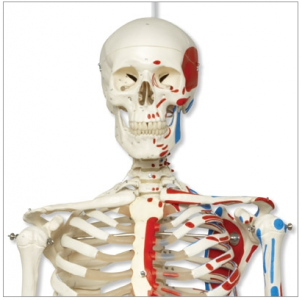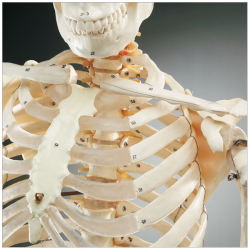The human skeletal system, the internal skeleton serves as a framework for the body, is one of the most difficult body components to study and observe. Human skeleton models and diagrams are the primary teaching tools used to teach students and patients. When it comes to choosing the right human skeleton model it is important to familiarize yourself with the skeletal system.
The skeleton consists of bones, cartilage, joints, and ligaments. Humans are born with approximately 350 bones. As they grow, some bones fuse together over time to form a single bone. As a result, adults have 206 individual bones.
The Two Divisions of the Human Skeleton
The bones of a human skeleton can be categorized into two divisions. The first group, axial skeleton, are the 80 bones that form the central axis of the human body and consist of the skull, vertebral column, and bony thorax. The axial skeleton bones support and protect the organs of the head, neck and trunk, including the skull, sternum, ribs, and vertebrae. The second group, appendicular skeleton, are the 126 bones that are related to our appendages, including the bones of the arms, hands, legs, feet, shoulder, and hip.
The location where two bones meet is called a joint. There are two types of joints in the human body; fixed joints and moving joints. The skull has 28 bones which are fused together with fixed joints. Moving joints allow for humans to twist and bend in different directions. There are two main types of moving joints, a hinge joint and a ball and socket joint. Ligaments are stretchy bands of tissue that hold together bones. In between the bones of a joint is a firm, rubbery tissue called cartilage. Cartilage acts as the body’s shock absorber.
Selecting the Right Human Skeleton Model
Now that we have covered the basics of the human skeletal system we can determine what type of human skeleton model will be right for your intended usage. The first step in selecting the right human skeleton model is identifying the criteria you will use to make your selection. Listed below are the six main categories that will clearly identify which human skeleton model is right for you.
- Basic Specifications; required assembly, display stand, gender, height, material, and numbered parts.
- Skeleton Details; herniated/prolapsed disk in spine, muscle origins/insertions marked, nerve branches marked, realistic texture, imitation tendons/ligaments, and vertebral artery marked.
- Flexible Parts; arms, fingers, jaw, joints, legs, and spine.
- Removable Parts; arms, calvarium (skull cap), feet, hands, legs, and teeth.
- Education Materials; bone guide, general anatomy information, and detailed bone information.
- Intended Uses; primary school, secondary school, doctor’s office, and physical therapy.


Leave a Reply